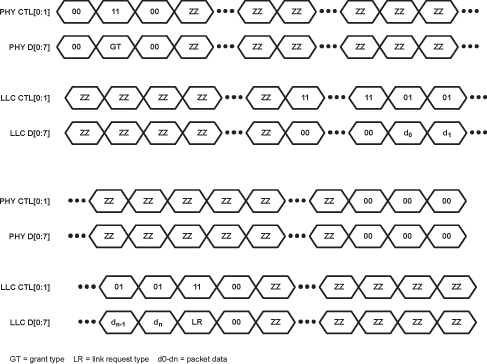JAJSQ90 september 2020 TSB41BA3F-EP
PRODUCTION DATA
- 1
- 1 特長
- 2 アプリケーション
- 3 概要
- 4 Revision History
- 5 Terminal Configuration and Functions
- 6 Specifications
- 7 Operating Life Deration
- 8 Parameter Measurement Information
- 9 Overview
- 10Functional Block Diagram
- 11Principles Of Operation (1394b Interface)
- 12Principles Of Operation (1394a-2000 Interface)
-
13Applications, Implementation, and Layout
- 13.1 Known exceptions to functional specification (errata).
- 13.2
Application Information
- 13.2.1 Interoperability with earlier revisions of TSB41BA3
- 13.2.2 Internal Register Configuration
- 13.2.3 Feature Enhancements to revision F
- 13.2.4 Power-Class Programming
- 13.2.5 Using The TSB41BA3F-EP With A 1394-1995 Or 1394a-2000 Link Layer
- 13.2.6 Power-Up Reset
- 13.2.7 Crystal Selection
- 13.2.8 Bus Reset
- 13.2.9 Designing With Powerpad™ Devices
- 14Device and Documentation Support
- 15Mechanical, Packaging, and Orderable Information
パッケージ・オプション
メカニカル・データ(パッケージ|ピン)
- PFP|80
サーマルパッド・メカニカル・データ
- PFP|80
発注情報
12.7 Transmit
When the LLC issues a bus request through the LREQ terminal, the PHY arbitrates to gain control of the bus. If the PHY wins arbitration for the serial bus, then the PHY-LLC interface bus is granted to the LLC by asserting the grant state (11b) on the CTL terminals and the grant type on the D terminals for one PCLK cycle, followed by idle for one clock cycle. The LLC then takes control of the bus by asserting either idle (00b), hold (11b), or transmit (01b) on the CTL terminals. If the PHY does not detect a hold or transmit state within eight PCLK cycles, then the PHY takes control of the PHY-link interface. The hold state is used by the LLC to retain control of the bus while it prepares data for transmission. The LLC can assert hold for zero or more clock cycles (that is, the LLC need not assert hold before transmit). During the hold state, the LLC is expected to drive the D lines to 0. The PHY asserts data-prefix on the serial bus during this time.
When the LLC is ready to send data, the LLC asserts transmit on the CTL terminals as well as sending the first bits of packet data on the D lines. The transmit state is held on the CTL terminals until the last bits of data have been sent. The LLC then asserts either hold or idle on the CTL terminals for one clock cycle. If the hold is asserted, then the hold is immediately followed by one clock cycle of idle. The link then releases the PHY-link interface by putting the CTL and D terminals in a high-impedance state. The PHY then regains control of the PHY-link interface.
 Figure 12-14 Transmit Packet Timing With Optional Link Request
Figure 12-14 Transmit Packet Timing With Optional Link RequestThe hold state asserted at the end of packet transmission allows the LLC to make an additional link request for packet transmission and/or to notify the PHY that the packet marks the end of a subaction. The link requests allowed after packet transmission are listed in Table 12-33 (note that the link request types allowed during this period are a subset of all of the allowed types of link requests—see Table 11-4). The associated speed codes and packet format are listed in Table 12-33 and Table 12-34, respectively. If the LLC requests to send an additional packet, then the PHY does not necessarily have to grant the request. If the LLC is notifying the PHY of the end of a subaction, then the LLC sets D4 during the hold state at the end of packet transmission.
| D1–D3 | Request Type |
|---|---|
| 000 | No request |
| 001 | Isoch_Req_Odd |
| 010 | Isoch_Req_Even |
| 011 | Current |
| 100 | Next_Even |
| 101 | Next_Odd |
| 110 | Cyc_Start_Req |
| 111 | Reserved |
| D5–D6 | DATA RATE |
|---|---|
| 00 | S100 |
| 01 | S200 |
| 10 | S400 |
| 11 | S800 |
| D0 | FORMAT |
|---|---|
| 0 | Link does not request either Beta or legacy packet format for bus transmission. |
| 1 | Link requests Beta packet format for bus transmission. |
| D4 | DESCRIPTION |
|---|---|
| 0 | Transmitted packet does not represent end of a subaction. |
| 1 | Transmitted packet marks the end of a subaction. |
The PHY indicates to the link during the GRANT cycle which type of grant is being issued. This indication includes the grant type as well as the grant speed. The link uses the bus grant for transmitting the granted packet type. The link transmits a granted packet type only if its request type exactly matches the granted speed and the granted format.
| D0 VALUE DURING GRANT CYCLE | FORMAT |
|---|---|
| 0 | Unspecified |
| 1 | Beta format |
| [D1–D3] VALUE DURING GRANT CYCLE | REQUEST TYPE |
|---|---|
| 000 | Reserved |
| 001 | Reserved |
| 010 | Isochronous grant |
| 011 | Reserved |
| 100 | Reserved |
| 101 | Asynchronous grant |
| 110 | Cycle start grant |
| 111 | Immediate grant |
| [D5–D6] VALUE DURING GRANT CYCLE | SPEED TYPE |
|---|---|
| 00 | S100 |
| 01 | S200 |
| 10 | S400 |
| 11 | S800 |